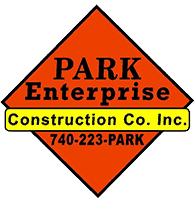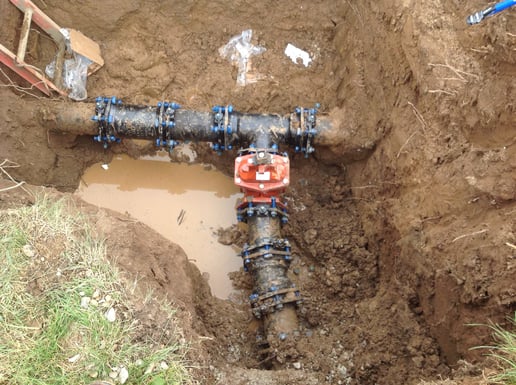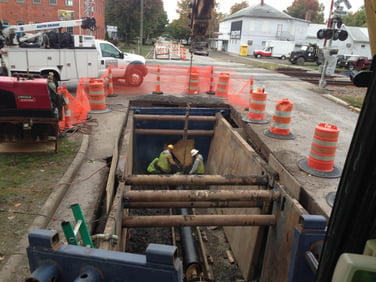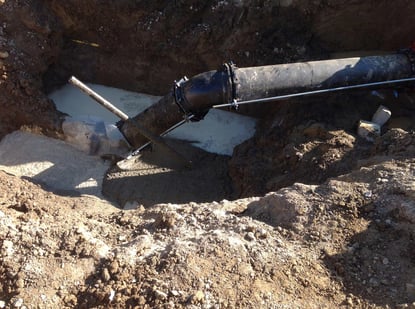If you’re asking yourself whether you have an underground water leak, unfortunately, you may have one.
You may already be experiencing one (or more) of these 11 signs of an underground water leak at your commercial building. These symptoms range from barely noticeable to “Act of God” in severity. In any case, call an experienced underground utility professional immediately if you bear witness to them.
(Helpful hint: Trust your gut - it’s better in the end to call and be wrong than not to call and be right.)
‘Do I Have an Underground Water Leak?’ Here are 11 Signs
In order (from least obvious to most):
1. Unusual Wet Spots in Landscaped Areas
“Well, that’s weird,” you say to yourself as you walk through a sloppy, wet patch of grass. “It didn’t rain.”
You’re right. But that water definitely came from somewhere, specifically your property’s underground water main. Somewhere several feet beneath your feet, a small- to medium-sized leak is trickling into the topsoil. It could be growing worse by the hour.
2. Soft, Mossy Areas
Over time, the wet area may grow more vegetation than usual. Grass will grow quicker and more thickly than on surrounding areas. Look out for different types of plants taking root, courtesy of additional water to sustain them.
Vehicles driving over the area could sink in the moist, soft soil. Even walking there could cause you or others to sink in slightly.
3. Pooling Water
This leak has gotten worse. A greater volume of water has reached the surface, enough to visibly pool in lower-lying spots. This could be a sign that the underground water leak has become more severe.
Keep in mind, water has amazingly intense erosive powers. If you don’t address this now, you could quickly risk the worst-case scenario (see #11).
4. Increasing Water Bills
You’re accustomed to paying roughly the same amount on each month’s water bill. It may change slightly with seasonal usage (for instance, if you use a sprinkler system in summer).
But one month, your eyes POP when looking at the bill, and the next month it’s even higher!
For perspective, a running toilet can waste thousands of gallons of water per month. So imagine the wasted water (and money) trickling (or spewing) from a leaking water main.
5. Sprinkler System Less Effective
If your company or organization does use a sprinkler system, you may notice it doesn’t work well anymore. It may take brown patches of grass in summer for you to pay attention earnestly.
While that could involve other unrelated problems within the irrigation system, it could be a simple question of water pressure. An underground water leak will diminish water pressure (see #6) needed to initiate your sprinklers.
6. Decreasing Water Flow or Pressure
Go wash your hands. How’s the water pressure? Is it flowing full force, as usual?
You may notice small changes in pressure over time, or all of the sudden the water slows to a trickle. While this, too, could stem from other issues within your plumbing system, a main leak could severely diminish the water volume and pressure entering your property.
7. Rusty or Roily Water
When an underground water utility breaks, it’s not only water that gets out. The ground composition outside the pipe can seep in, as well. In that case, your water will be turbid and muddy looking.
If your business is located in the Rust Belt (as we are), there’s a good chance parts of the water and sewer infrastructure servicing your communities are decades old, if not nearly a century. Even a small break could push pieces of the decayed and rusted pipe into your water to impact its quality. The source could very well be elsewhere within the local water system, but in the interest of preventing severe damage at your property it’s best to call a professional to investigate.
8. The Sound
Sometimes you can literally hear the leaking water underground. Depending on the severity, you could hear what sounds like a babbling brook or an intense “whooshing.” Sometimes you may even hear small rocks “clinking” down the pipe. Those rocks wouldn’t be there if there weren’t a sizeable hole in the pipe.
The “whooshing” noise would indicate a line with a water pressure greater than 30 psi has burst. That’s a serious emergency. Call a professional immediately.
9. Unnatural Pavement Cracking or Heaving
Underground water leaks will push to the surface. Sometimes surfacing will happen underneath a paved surface like a sidewalk, bike path, road, or parking lot. When that happens, the water will have virtually no place to go, causing the ground to heave and push the paved surface up with it.
Be on the lookout for unexplained swelling and cracking. They’re signs of impending doom.
10. Uneven Structure
The underground water leak has become so severe it is pushing up parts of nearby buildings. You’ll notice uneven grades in walkways and floors. The walls that you once thought were so sturdy could begin leaning.
If this begins happening, run and call for help. The property has already incurred significant damage and it’s most likely no longer safe inside.
11. Potholes and Sinkholes
Water erodes, plain and simple. Look at the Grand Canyon.
The water leaking underneath your commercial property will do more than just sit there. It’ll eventually weaken and erode the ground beneath you. To your parking lot, the best-case scenario is a series of potholes. To your entire property, the worst-case scenario is a massive sinkhole that can swallow cars, structures … and people, like something out of a nightmare.
The Physics Behind (or Rather Underneath) a Sinkhole:
Basically, water from a broken water line or sewer line seeps or pours into the ground beneath the topsoil. It then erodes the subsurface and causes the topsoil and any structures and driving surfaces above it to collapse.
We deal most often with sinkholes in driving surfaces and around stormwater catch basins. Catch basins can be tricky. Who regularly inspects their catch basin? Well, you should. A hole can open in the pipe, allowing water to escape and erode the subsurface dirt and stone around the basin. It’s quite common as winter becomes spring and underground stormwater systems become inundated with thousands or even millions of gallons of water.
Next thing you know, a vehicle drives overhead and goes for the ride of its life. Let’s pray everyone’s OK!
To spot trouble before it gets worse, you should regularly inspect your catch basin for stone, dirt, or other material that wouldn’t otherwise be there. That’s a telltale sign of erosion nearby. You should also inspect your property, especially driving surfaces and buildings, for unexplained cracking and heaving. The Devil is in those details.
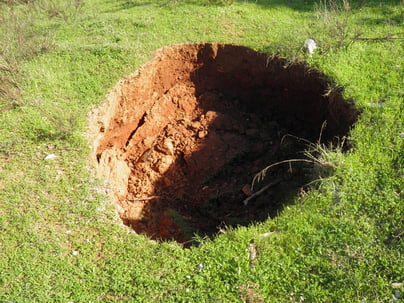
Let’s hope you catch the problem before this happens.
But What if It’s Too Late to Prevent a Sinkhole?
Unfortunately, like many things in life, the signs aren’t obvious until after disaster strikes. Or you could be diligent with routine maintenance in one place only to discover issues cropping up elsewhere.
Call a professional if you spot water where it shouldn’t be or anything else unusual. A relatively minor fix today could avoid a bankrupting catastrophe tomorrow.
Of course, if your commercial property in Central Ohio is experiencing underground utility problems or signs of a sinkhole, feel free to give us a call at (740) 223-7275. We’d be happy to take a look for you.
